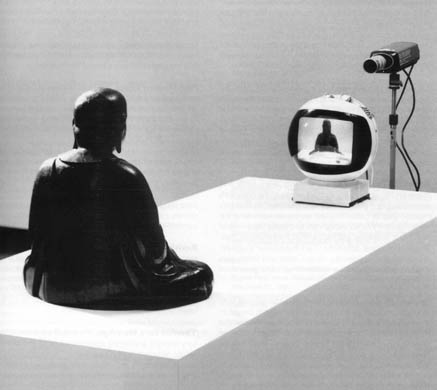Introduction
The term Buddha refers to the most respected form of religious and philosophical spirit in the Asian continent. On the other hand, TV Buddha is an artwork interpreted by a famous Video artist whose name was Nam June Paik. Wardrip-Fruin & Montfort (127) noted that “the artwork consisted of a Buddha statue facing a video screen that has its image which was projected using a closed-circuit video camera”. The significance of Buddha is respected very much by the people of Asia. According to Wardrip-Fruin & Montfort (227) “the historical/religious significance of the Buddha figure makes it an apt metaphor for contemplation, yet there seems to be a conflict between the desires to look away from and into the self”. The purpose of the paper is to describe the art using formalism and iconography.
Discussion
Nam June Paik was born on 20th July 1932 in Seoul, Korea. He was a holder of a Bachelor of Aesthetics degree from Tokyo University even though he ended up in the field of electronic music. This change of career came after the artist met John Cage who was an American composer of the avant-garde. The artist started creating multimedia concerts for electronic music by the use of television sets. Most of his early works dealt with making comments on how contemporary society depended highly on television for entertainment purposes. This phenomenon attracted his attention due to the passiveness associated with viewing television. Another factor that led him to focus on television entertainment was the rates at which people were accessing and inventing televisions.
TV Buddha was one of the works that Nam June Paik commented on in the course of his career. TV Buddha featured an eighteenth century Buddha watching an image of his own on the television. According to the artist, the art work represented the lack of reflection in the universal body. The universal body represents the relevance of Buddha or of any other living organism. The artist argued that the universal body is pervaded by all living creatures for the sake of gaining the real truth. Due to the determination that the minds of living beings have while watching TV, it is therefore clear that there should be no objection of an instance when the body is reflected on a screen. The artist argued that even light or obstacle which may cause an image to be formed should not be facts to oppose the case of body reflection. The artist further argued that anything that does not have an image, cannot be reflected or lacks shadow is real and thus it resembles the state of Nirvana.
According to Decker-Phillips, Paik has managed to create an infinite loop. It becomes more interesting to the viewer as he/she realises that while the discourse of technology can be distanced from the conflict taking place, i.e. that the struggle is ultimately between the self and perception of the self, it also can be said to be a catalyst for the interaction which forces the interaction between the two (78).
The artist expressed his worry on the moral consequences that are associated with pictures in telephone. For instance, the artist argued that when one receives a telephone call at night, such a person cannot be seen dressed in pajamas. The artist was sure that he understood time factor much better that those video artists who came from the art of painting-sculptor. According to the artist, music results from the manipulation of time factor. This is the reason why the different types of music have unique structures and build-ups. The artist indicated that he differed with painters for the fact that he understood the time factor better while painters understood the space factor better. He expressed how technology grew with time. For instance, he could not imagine a time when one would be in a position to watch a television program from a computer. He was highly confident that due to the advancement in technology and the nature that human beings relying on hardware, such a time would come.
The contemporary society has been associated with the application of technology in most of the activities. This trend resulted from the concept of avant-gurde, a term used by the military to refer to advance guard (Wardrip-Fruin, 23). The artists of the avant-garde time were termed as being ahead of their time because of their high rates of inventing new technologies. One of the major developments was the shift from the traditional methods of income generation to advanced methods. Modern art was boosted by the western society’s intention to come close to industrial and secular societies during the nineteenth century. As noted by Christiane (45) “modern artist have challenged middle- class values by depicting new subjects in disquieting new styles that seemed to change at a dizzing pace”.
Conclusion
Nam June Paik interpreted TV Buddha using formalism to indicate how technology has advanced in the field of art. The artist imagined how the Buddha would see his image on the television with the projection of a closed circuit video. The artist indicated how real the universal body would appear after reflection, he indicated that any non-image thing is real as a result of technology advancement.

Works Cited
Christiane, Paul. Digital Art. London: Thames & Hudson, 2002.
Decker-Phillips, Edward. Paik Video. New York: Barry town Press, 1998.
Wardrip-Fruin, Noah & Montfort, Nick. The New Media Reader. New Delhi: MIT Press, 2003.